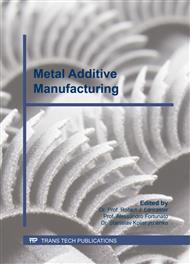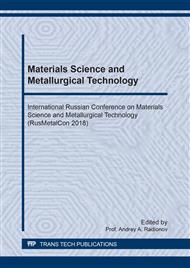[1]
Superalloys II: High-temperature materials for aerospace and industrial plants (in Russian). Moscow: Metallurgy, (1995).
Google Scholar
[2]
Additive manufacturing in mechanical engineering (in Russian). Saint-Petersburg: Polytechnical University press, (2013).
Google Scholar
[3]
E. Chlebus, B. Kuźnicka, T. Kurzynowski, B. Dybała, Microstructure and mechanical behaviour of Ti―6Al―7Nb alloy produced by selective laser melting. Materials Characterization, 62(5) (2011) 488-495.
DOI: 10.1016/j.matchar.2011.03.006
Google Scholar
[4]
A. Popovich, V. Sufiiarov, I. Polozov, E. Borisov, D. Masaylo, Producing hip implants of titanium alloys by additive manufacturing. International Journal of Bioprinting, 2(2) (2016) 187-193.
DOI: 10.18063/ijb.2016.02.004
Google Scholar
[5]
A. Popovich, V. Sufiiarov, E. Borisov, I. Polozov, Microstructure and Mechanical Properties of Ti-6AL-4V Manufactured by SLM. Key Engineering Materials, (2015).
DOI: 10.4028/www.scientific.net/kem.651-653.677
Google Scholar
[6]
A.A. Popovich, V.S. Sufiiarov, E.V. Borisov, I.A. Polozov, D.V. Masaylo, A.V. Grigoriev, Anisotropy of mechanical properties of products manufactured using selective laser melting of powdered materials. Russian Journal of Non-Ferrous Metals, 58(4) (2017) 389-395.
DOI: 10.3103/s1067821217040149
Google Scholar
[7]
V.S. Sufiiarov, A.A. Popovich, E.V. Borisov, I.A. Polozov, D.V. Masaylo, A.V. Orlov, The effect of layer thickness at selective laser melting. Procedia engineering, 174 (2017) 126-134.
DOI: 10.1016/j.proeng.2017.01.179
Google Scholar
[8]
H. Attar, M. Calin, L.C. Zhang, S. Scudino, J. Eckert, Manufacture by selective laser melting and mechanical behavior of commercially pure titanium. Materials Science and Engineering: A, 593 (2014) 170-177.
DOI: 10.1016/j.msea.2013.11.038
Google Scholar
[9]
B. Vrancken, L. Thijs, J.P. Kruth, J. Van Humbeeck, Heat treatment of Ti6Al4V produced by Selective Laser Melting: Microstructure and mechanical properties. Journal of Alloys and Compounds, 541 (2012) 177-185.
DOI: 10.1016/j.jallcom.2012.07.022
Google Scholar
[10]
T. Vilaro, C. Colin, J. D. Bartout, As-fabricated and heat-treated microstructures of the Ti-6Al-4V alloy processed by selective laser melting. Metallurgical and Materials Transactions A, 42(10) (2011) 3190-3199.
DOI: 10.1007/s11661-011-0731-y
Google Scholar
[11]
L. Facchini, E. Magalini, P. Robotti, A. Molinari, S. Höges, K. Wissenbach, Ductility of a Ti-6Al-4V alloy produced by selective laser melting of prealloyed powders. Rapid Prototyping Journal, 16(6) (2010) 450-459.
DOI: 10.1108/13552541011083371
Google Scholar
[12]
ASTM F1580 – 12 Standard Specification for Titanium and Titanium-6 Aluminum-4 Vanadium Alloy Powders for Coatings of Surgical Implants.
DOI: 10.1520/f1580-95
Google Scholar
[13]
S. Van Bael, Y.C. Chai, S. Truscello, M. Moesen, G. Kerckhofs, H. Van Oosterwyck, J. Schrooten, The effect of pore geometry on the in vitro biological behavior of human periosteum-derived cells seeded on selective laser-melted Ti6Al4V bone scaffolds. Acta biomaterialia, 8(7) (2012) 2824-2834.
DOI: 10.1016/j.actbio.2012.04.001
Google Scholar
[14]
Analysis and simulation of the process of dendritic inhomogeneity formation in steel towards its reduction (in Russian). Ph.D. thesis in Engineering Science, Saint-Petersburg: SPbSTU, (2013).
Google Scholar
[15]
V.M. Golod, V.S. Sufiiarov, The evolution of structural and chemical heterogeneity during rapid solidification at gas atomization. In IOP Conference Series: Materials Science and Engineering, 192(1) (2017) 012009.
DOI: 10.1088/1757-899x/192/1/012009
Google Scholar
[16]
ASTM F2924 - 14 Standard Specification for Additive Manufacturing Titanium-6 Aluminum-4 Vanadium with Powder Bed Fusion.
DOI: 10.1520/f2924-14r21
Google Scholar
[17]
Information on http://www.bibusmetals.com.ua/fileadmin/materials/PDF/catalogs_new_2013 /titan/Titan_Grade_5_RU_EN.pdf.
Google Scholar
[18]
GOST R ISO 5832-3 Implantaty dlya khirurgii. Metallicheskie materialy. CHast' 3. Deformiruemyj splav na osnove titana, 6-alyuminiya i 4-vanadiya (State standard 5832-3 Implants for surgery. Metallic materials. Part 3: Wrought titanium 6-aluminium 4-vanadium alloy).
DOI: 10.3403/00977375u
Google Scholar
[19]
V.S. Sufiiarov, A.A. Popovich, E.V. Borisov, I. Polozov, Selective laser melting of titanium alloy and manufacturing of gas-turbine engine part blanks. Tsvetnye Metally, 8 (2015) 76-80.
DOI: 10.17580/tsm.2015.08.11
Google Scholar
[20]
P.C. Collins, B. Welk, T. Searles, J. Tiley, J.C. Russ, H.L. Fraser, Development of methods for the quantification of microstructural features in α+ β-processed α/β titanium alloys. Materials Science and Engineering: A, 508(1-2) (2009)174-182.
DOI: 10.1016/j.msea.2008.12.038
Google Scholar



